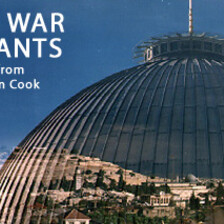The Electronic Intifada 8 March 2006
Thousands of Nazarenes rushed to the Basilica of the Annunciation in the early evening of Friday March 3, as rumours swept the city that their church was under attack. Built over the grotto where the archangel Gabriel is supposed to have revealed to Mary that she was bearing the son of God, the Basilica is one of Christianity’s holiest sites. As local people streamed into the church’s walled-off courtyard, they learnt that three intruders had detonated a series of small explosions inside the building at 5.30pm, during a special ceremony for Lent.
For several minutes the congregation huddled together in fear of their lives before a priest and several churchgoers managed to overpower a grey-bearded man in jeans, 44-year-old Haim Habibi, an Israeli Jew accompanied by his wife, Violet, and the couple’s 20-year-old daughter Odelia.
As angry bystanders began beating Habibi, priests and a small contingent of local policemen hurried the three intruders into an annex of the church, where they were locked up for their own safety. There followed a stand-off between police and the crowd for the next four hours.
Almost from the outset the Israeli media downplayed the significance of the attack, saying only “firecrackers” had been set off by Habibi, who was described - without evidence - as being mentally disturbed. As a result, most of the world’s media ignored the event entirely. These pictures capture some of that night’s dramatic events and a joint Christian and Muslim protest march through Nazareth the next day.
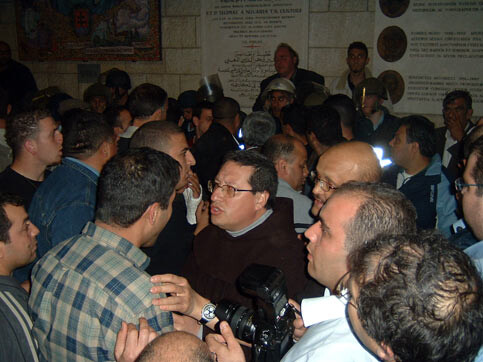
Watched by riot police wearing visors, Nazarenes swarm around the annex room where Haim Habibi, his wife and his daughter are holed up. Most in the crowd assumed at this stage that the explosions had been a terror attack organised by Jewish extremists. Six months earlier, in an attempt to stop the disengagement, an Israeli soldier, Natan Eden Zada, used his army rifle to spray a bus with bullets, killing two Christians and two Muslims, in the neighbouring community of Shafa’amr. Zada apparently believed he was following in the footsteps of Baruch Goldstein who massacred 29 Muslim worshippers in Hebron in 1994. (Photo: Jonathan Cook)
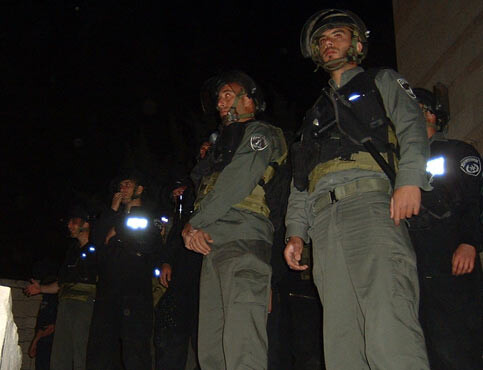
Large numbers of riot police are drafted in as the stand-off wears on. Stun grenades and tear gas are repeatedly into the crowd but in a departure from normal Israeli methods of policing disturbances in Arab communities, neither batons nor rubber bullets are used. In the first week of the Second Intifada, 13 unarmed Arab demonstrators, including three Nazarenes, were shot dead by police with rubber bullets and live ammunition. In the intervening period, another 19 Arab citizens have died at the hands of the police in mysterious circumstances. Community leaders speculated that on this occasion the police had been warned not to compound the violation of holy ground by assaulting members of the crowd. (Photo: Jonathan Cook)
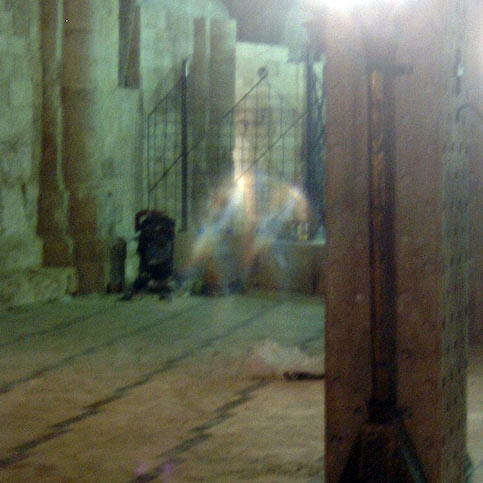
The pushchair Habibi used to transport his fireworks, seen through the thick windows of the sealed-off church. The pushchair was for one of his three children who have been taken into foster care (including one who has reportedly been housed with a family in a West Bank settlement). Habibi later said his attack was designed to draw attention to his desperate plight. Although the Israeli media referred to “firecrackers”, they glossed over other evidence that Habibi planned a much worse attack. The Arab Association for Human Rights in Nazareth says Habibi had also packed the pushchair with small gas canisters, together with marbles and pieces of metal. (Photo: Jonathan Cook)
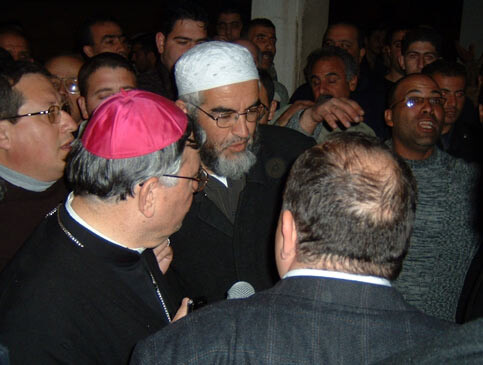
Sheikh Raed Salah, leader of the Islamic Movement in Israel, joins the Latin Patriarch Michel Sabbagh in a vigil outside the church. Christian and Muslim leaders were united in their condemnation of the attack, prompting much discomfort from the Israeli media and government ministers. The next day the Yediot Aharanot newspaper led the accusations against the Muslim leadership in an article headlined “Muslim hitch-hikers on a Christian ride”. Acting prime minister Ehud Olmert also tried to sow sectarian discord by declaring: “There is something almost ridiculous in the fact that the Muslim public, which is intolerant of Christianity and its leaders, is at the forefront of the protest against an incident carried out by a weird couple and is trying to leverage the incident for election campaign purposes.” (Photo: Jonathan Cook)

At about 9.15pm, a police car is overturned and set alight on Casa Nova street, directly outside the church courtyard. At much the same time the three intruders are smuggled out of the church disguised as police officers. Who set the car on fire? It is difficult to know, though the media presumed it was the demonstrators. The blazing car provided the perfect distraction while the family was evacuated. Mistarvim - undercover agents supposed to look like Arab shebab (“young men”) and frequently used in West Bank operations - were more conspicuous in the church grounds to this close-knit community than they may have realised. (Photo: Jonathan Cook)

Riot police prepare to leave the courtyard, mission accomplished, as the fire in the street outside can be seen through the window. The walls of courtyard are covered by murals and paintings of the Virgin Mary, donated by congregations from around the world. One young eyewitness, 12-year-old Subhi Espanioly, says he noticed the Habibis looking at the murals as he arrived at the church for the Lent service. (Photo: Jonathan Cook)
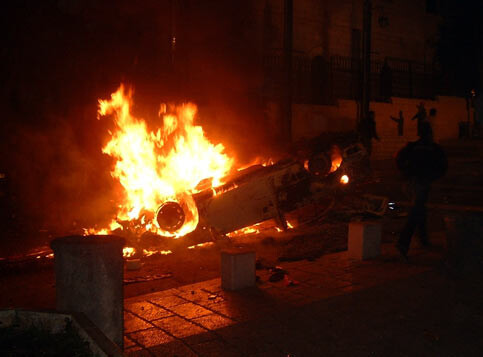
The overturned police car on fire on Casa Nova street, directly outside the church courtyard. (Photo: Jonathan Cook)
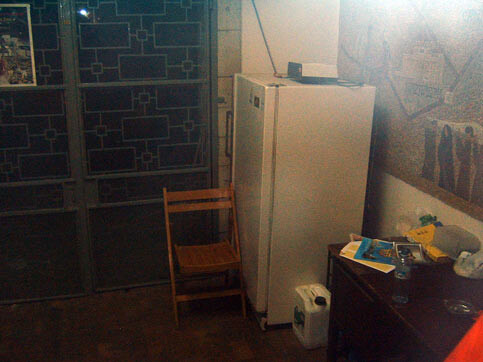
The annex room where the Habibis were holed up for nearly four hours, protected by police. Nazarenes expressed similar reasons for wanting to stay in the courtyard for the duration. Justice, they all pointed out, was rarely done when it involved punishing Jews for attacks against Arabs. It was difficult to turn away and let these intruders, like so many of their predecssors, walk into the sympathetic embrace of the Israeli authorities. The crowd hoped to show anyone who might consider emulating such an attack that the community would not easily allow itself to be a target again. (Photo: Jonathan Cook)

Nazarenes, still in shock, listen to speeches by religious leaders in the courtyard of the Basilica of the Annunciation on Saturday March 4. (Photo: Jonathan Cook)
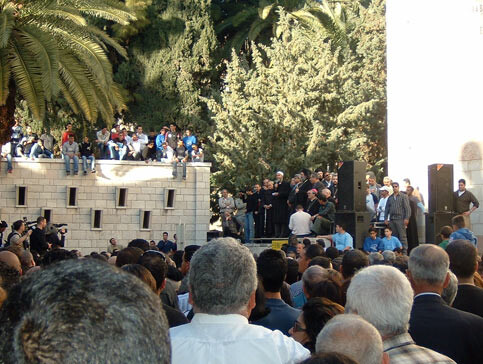
Community and religious leaders address the crowd in the Basilica’s courtyard. Already the Israeli media had started to offer extenuating circumstances, in addition to Habibi’s presumed mental illness, for the attack, including the claim that the family was suffering from “economic distress”. In response MK Ahmed Tibi observed: “I understand that this man has a personal problem. But why bring it up by burning a mosque or blowing up a church? The reason is the anti-Arab atmosphere in Israel.” The I’lam media centre in Nazareth also pointed out that the Israeli public were never alerted by their media “to the personal tragedies of Palestinians who commit suicide operations, where the focus is on the nationalistic context of such operations instead.” (Photo: Jonathan Cook)
Jonathan Cook is a writer and journalist based in Nazareth. His book “Blood and Religion: the Unmasking of the Jewish and Democratic State” is published by Pluto next month. His website is www.jkcook.net




